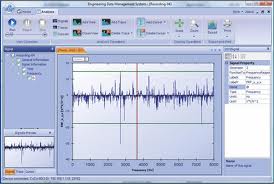Condition Monitoring
Condition Monitoring is the process of monitoring a parameter of condition in machinery, such that a significant change is indicative of a developing failure. It is a major component of predictive maintenance. The use of conditional monitoring allows maintenance to be scheduled, or other actions to be taken to avoid the consequences of failure, before the failure occurs. Nevertheless, a deviation from a reference value must occur to identify impeding damages. Predictive Maintenance does not predict failure. Machines with defects are more at risk of failure than defect free machines. Once a defect has been identified, the failure process has already commenced and CM systems can only measure the deterioration of the condition. Intervention in the early stages of deterioration is usually much more cost effective than allowing the machinery to fail. Condition monitoring has a unique benefit in that the actual load, and subsequent heat dissipation that represents normal service can be seen and conditions that would shorten normal lifespan can be addressed before repeated failures occur. Service able machinery include rotating equipment and stationary plant such as boilers and Heat Exchangers.
Rotating equipment
The most commonly used method for rotating machines is called Vibration Analysis.Measurements can be taken on machine bearing casings with seismic or piezo-electric transducers to measure the casing vibrations, and on the vast majority of critical machines, with eddy-current transducers that directly observe the rotating shafts to measure the radial vibration of the shaft. The level of vibration can be compared with historical baseline values such as former startups and shutdowns, and in some cases established standards such as load changes, to assess the severity.
Interpreting the vibration signal obtained is a complex process that requires specialized training and experience. Exceptions are state-of-the-art technologies that provide the vast majority of data analysis automatically and provide information instead of data. One commonly employed technique is to examine the individual frequencies present in the signal. These frequencies correspond to certain mechanical components (for example, the various pieces that make up a rolling-element bearing) or certain malfunctions (such as shaft unbalance or misalignment). By examining these frequencies and their harmonics, the analyst can often identify the location and type of problem, and sometimes the root cause as well. For example, high vibration at the frequency corresponding to the speed of rotation is most often due to residual imbalance and is corrected by balancing the machine.
As another example, a degrading rolling-element bearing will usually exhibit increasing vibration signals at specific frequencies as it wears. Special analysis instruments can detect this wear weeks or even months before failure, giving ample warning to schedule replacement before a failure which could cause a much longer down-time. Beside all sensors and data analysis it is important to keep in mind that more than 80% of all complex mechanical equipment fail accidentally and without any relation to their life-cycle period.
Most vibration analysis instruments today utilize a Fast Fourier Transform (FFT) which is a special case of the generalized Discrete Fourier Transform and converts the vibration signal from its time domain representation to its equivalent frequency domain representation. However, frequency analysis (sometimes called Spectral Analysis or Vibration Signature Analysis) is only one aspect of interpreting the information contained in a vibration signal. Frequency analysis tends to be most useful on machines that employ rolling element bearings and whose main failure modes tend to be the degradation of those bearings, which typically exhibit an increase in characteristic frequencies associated with the bearing geometries and constructions. In contrast, depending on the type of machine, its typical malfunctions, the bearing types employed, rotational speeds, and other factors, the skilled analyst will often need to utilize additional diagnostic tools, such as examining the time domain signal, the phase relationship between vibration components and a timing mark on the machine shaft (often known as a keyphasor), historical trends of vibration levels, the shape of vibration, and numerous other aspects of the signal along with other information from the process such as load, bearing temperatures, flow rates, valve positions and pressures to provide an accurate diagnosis. This is particularly true of machines that use fluid bearings rather than rolling-element bearings. To enable them to look at this data in a more simplified form vibration analysts or machinery diagnostic engineers have adopted a number of mathematical plots to show machine problems and running characteristics, these plots include the bode plot, the waterfall plot, thepolar plot and the orbit time base plot amongst others.
Handheld data collectors and Analyzers are now commonplace on non-critical or balance of plant machines on which permanent on-line vibration instrumentation cannot be economically justified. The technician can collect data samples from a number of machines, then download the data into a computer where the analyst and sometimes artificial intelligence can examine the data for changes indicative of malfunctions and impending failures. For larger, more critical machines where safety implications, production interruptions so-called downtime, replacement parts, and other costs of failure can be appreciable , a permanent monitoring system is typically employed rather than relying on periodic handheld data collection. However, the diagnostic methods and tools available from either approach are generally the same.
Recently also on-line systems have been applied to heavy process industries such as pulp, paper, mining, petrochemical and power generation. These can be dedicated systems like Sensodec 6S or nowadays this functionality has been embedded into DCS.
Performance monitoring is a less well-known condition monitoring technique. It can be applied to rotating machinery such as pumps and turbines, as well as stationary items such as boilers and heat exchangers. Measurements are required of physical quantities: temperature, pressure, flow, speed, displacement, according to the plant item. Absolute accuracy is rarely necessary, but repeatable data is needed. Calibrated test instruments are usually needed, but some success has been achieved in plant with DCS (Distributed Control Systems). Performance analysis is often closely related to energy efficiency, and therefore has long been applied in steam power generation plants. Typical applications in power generation could be boiler, steam turbine and gas turbine. In some cases, it is possible to calculate the optimum time for overhaul to restore degraded performance.
Other techniques
- Often visual inspections are considered to form an underlying component of condition monitoring, however this is only true if the inspection results can be measured or critiqued against a documented set of guidelines. For these inspections to be considered condition monitoring, the results and the conditions at the time of observation must be collated to allow for comparative analysis against the previous and future measurements. The act of simply visually inspecting a section of pipework for the presence of cracks or leaks cannot be considered condition monitoring unless quantifiable parameters exist to support the inspection and a relative comparison is made against previous inspections. An act performed in isolation to previous inspections is considered a Condition Assessment, Condition Monitoring activities require that analysis is made comparative to previous data and reports the trending of that comparison.
- Slight temperature variations across a surface can be discovered with visual inspection and non-destructive testing with thermography. Heat is indicative of failing components, especially degrading electrical contacts and terminations. Thermography can also be successfully applied to high-speed bearings, fluid couplings, conveyor rollers, and storage tank internal build-up.* Using a Scanning Electron Microscope of a carefully taken sample of debris suspended in lubricating oil (taken from filters or magnetic chip detectors). Instruments then reveal the elements contained, their proportions, size and morphology. Using this method, the site, the mechanical failure mechanism and the time to eventual failure may be determined. This is called WDA - Wear Debris Analysis.
- Spectrographic oil analysis that tests the chemical composition of the oil can be used to predict failure modes. For example a high silicon content indicates contamination of grit etc., and high iron levels indicate wearing components. Individually, elements give fair indications, but when used together they can very accurately determine failure modes e.g. for internal combustion engines, the presence of iron/alloy, and carbon would indicate worn piston rings.* Ultrasound can be used for high-speed and slow-speed mechanical applications and for high-pressure fluid situations. Digital ultrasonic meters measure high frequency signals from bearings and display the result as a dBuV (decibels per microvolt) value. This value is trended over time and used to predict increases in friction, rubbing, impacting, and other bearing defects. The dBuV value is also used to predict proper intervals for re-lubrication. Ultrasound monitoring, if done properly, proves out to be a great companion technology for vibration analysis.
Headphones allow humans to listen to ultrasound as well. A high pitched buzzing sound in Bearings indicates flaws in the contact surfaces, and when partial blockages occur in high pressure fluids the orifice will cause a large amount of ultrasonic noise. Ultrasound is used in the Shock Pulse Method of condition monitoring.
- Performance analysis, where the physical efficiency, performance, or condition is found by comparing actual parameters against an ideal model. Deterioration is typically the cause of difference in the readings. After motors, centrifugal pumps are arguably the most common machines. Condition monitoring by a simple head-flow test near duty point using repeatable measurements has long been used but could be more widely adopted. An extension of this method can be used to calculate the best time to overhaul a pump based on balancing the cost of overhaul against the increasing energy consumption that occurs as a pump wears. Aviation gas turbines are also commonly monitored using performance analysis techniques with the original equipment manufacturers such as Rolls-Royce plc routinely monitoring whole fleets of aircraft engines under Long Term Service Agreements (LTSAs) or Total Care packages.
- Wear Debris Detection Sensors are capable of detecting ferrous and non-ferrous wear particles within the lubrication oil giving considerable information about the condition of the measured machinery. By creating and monitoring a trend of what debris is being generated it is possible to detect faults prior to catastrophic failure of rotating equipment such as gearbox's, turbines, etc.

